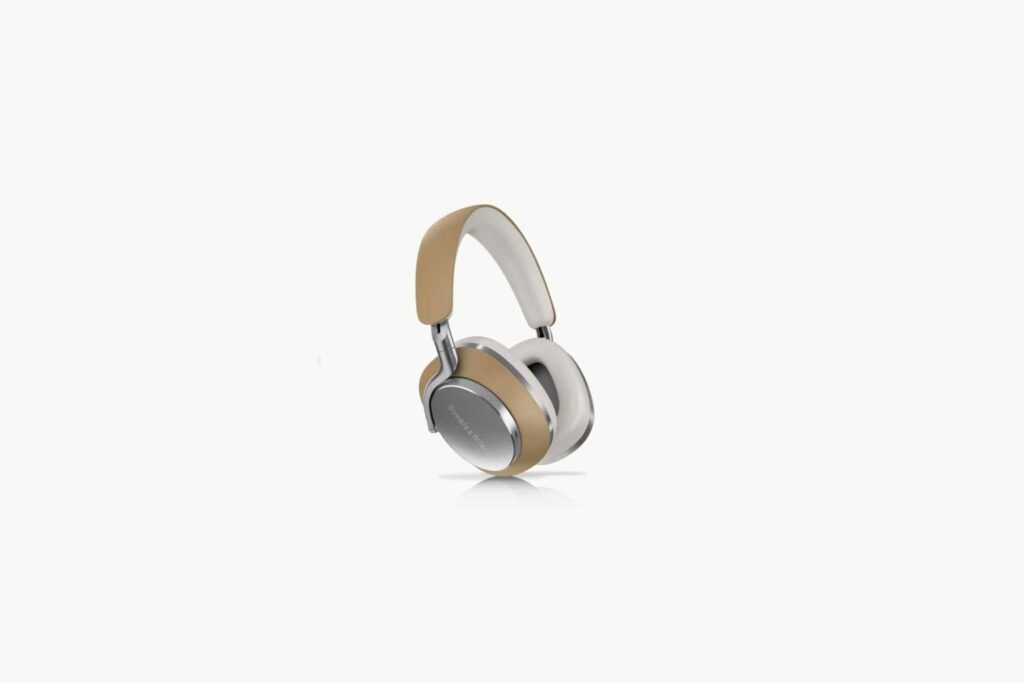Bowers & Wilkins, the renowned British premium audio brand, has launched its new flagship wireless headphone, the Bowers & Wilkins Px8 (read the review). The new model sets a new reference standard for the brand on sound, build and finish in the active noise cancelling wireless headphone category.
The heart of the Px8 is the same active noise cancelling wireless platform found in the Bowers & Wilkins Px7 S2, one of the more critically acclaimed headphones in the class. In Px8 achieves even greater heights of detail, resolution and spaciousness thanks to all-new bespoke 40mm Carbon Cone drive units.
Inspired by the Carbon Dome drive units used in Bowers & Wilkins highly successful 700 Series loudspeaker range like the Bowers & Wilkins 702 S3 speakers (read the review), the Px8’s new Carbon Cones deliver a combination of ultra-fast response plus exceptionally low distortion throughout the frequency range. The result is resolution, detail and timing that surpasses the high bar set by the Px7 S2, ensuring an even more engaging and natural musical performance that gets closer than ever to the true sound of the artist’s intent.

The Carbon Cone drive units in Px8 are carefully angled inside each earcup to ensure aconsistent distance relative to the listener’s ear from every point across the surface of eachdriver, to produce a more immersive and highly accurate soundstage. The result is the best sound quality Bowers & Wilkins has ever delivered from a pair of audiophile wireless headphones.
A Statement In Headphone Design
The new headphone is available in two finishes, black leather or tan leather and now has a cast-aluminum arm structure that references Bowers & Wilkins signature design language, plus a diamond-cut bright edge on each elliptical logo plate. The earcups, memory-foam cushionsand headband are trimmed in soft, luxurious Napa leather for the ultimate, premium feel. Together, these design and material choices ensure that Px8 confidently asserts Bowers &Wilkins’ position as a premium audio brand like no other in the category.
High-Resolution Sound
The Px8 uses Qualcomm’s aptXTM Adaptive wireless technology to ensure the best possible sound quality from compatible phones, tablets and computers. USB-C and 3.5mm analoguecable connections are also supported, with both cable types included in the carry case that accompanies the product.
Whether using wireless or wired connections, the Px8 combines its ultra-high-performance drive unit configuration with powerful Bowers & Wilkins-developed DSP (Digital Signal Processing) to deliver outstanding, 24-bit high-resolution sound quality from leading streaming services.

Cancel The Noise
The Px8 uses proprietary Bowers & Wilkins-optimized noise cancellation technology to effectively shut out unwanted noise – crucially, without harming musicality in the process.
Six high-performance microphones work together to deliver the best results: two measure theoutput of each drive unit, two react to ambient noise from the outside world and two provide outstanding voice clarity with enhanced noise suppression.
As with Px7 S2, the performance of the system has been further improved by moving the two external microphones closer together, adjusting the angling of each microphone to improve voice capture and changing the position of the second mic to reduce wind noise interference.
A Breakthrough in User Experience
Excitingly, the launch of the new Px8 will see a major upgrade for the Bowers & Wilkins Music App. From launch, the Music App will allow Px8 users to stream their chosen music directly from their mobile device to their headphones, with Deezer, Qobuz and TIDAL all supported.
The same functionality will roll out to owners of Px7 S2 on the day Px8 launches. As just one example of the benefits of this breakthrough feature, Bowers & Wilkins customers can now easily switch between listening at home – for example, via a Zeppelin, or a pair of the Formation Duo stereo speakers – and listening on the move via a mobile device with a pair of Px8 or Px7 S2 headphones.
As before, the Music App also simplifies connection of the Px8 to a mobile device, supports fine-tuning of the sound through adjustable EQ, and allows owners to configure their preferred noise-cancelling mode, all while monitoring the headphone’s charge levels.
More Headphone Reviews Can Be Found In Our Audiophile Headphone Review Category.
How Bowers & Wilkins Got Into the Headphone Business
Bowers & Wilkins, a British company known for designing and manufacturing high-performance loudspeakers since 1966, began exploring the headphone market as personal audio technology evolved. With changes in consumer behavior and the rapid adoption of smartphones and portable music players, it became clear that the future of music listening would include a significant mobile component. As a result, Bowers & Wilkins made the strategic decision to bring its long-standing expertise in sound reproduction into the personal audio space.
The company’s entrance into the headphone category began in 2010 with the release of the P5, a wired on-ear headphone designed to reflect the brand’s sound philosophy and premium aesthetic. At the time, the headphone market was already expanding, with many brands competing in the consumer segment. Bowers & Wilkins approached the category from a different angle, emphasizing sonic accuracy, high-quality materials, and restrained design. The P5 featured lambskin leather ear pads, brushed aluminum accents, and magnetic ear cups that allowed for easy cable replacement. More importantly, its tuning reflected the same priorities as Bowers & Wilkins loudspeakers—natural midrange, balanced bass, and clear treble without excessive coloration.
Following the P5’s commercial success, Bowers & Wilkins expanded its headphone offerings. The P3, a more compact on-ear model, offered similar styling with slightly smaller drivers and a lower price point. The P7, released in 2013, marked the company’s first over-ear headphone and featured larger drivers housed in a circumaural design, providing better isolation and improved bass response. Each model was tuned by the same engineering team responsible for the company’s loudspeakers, maintaining a level of continuity across product lines.
The transition to wireless technology was the next logical step. With consumer demand shifting toward Bluetooth-enabled devices and mobile-first usage, Bowers & Wilkins developed headphones that combined wireless convenience with its signature sound quality. The PX, released in 2017, was the company’s first wireless headphone with active noise cancellation (ANC). It included proximity sensors that automatically paused or resumed playback when the headphones were removed or worn, and it supported aptX HD for higher-quality wireless streaming. The design maintained the premium materials found in earlier models but incorporated more advanced internal components, including a digital signal processor for real-time sound adjustments.
The PX was followed by the PX7, which introduced a new 43.6mm custom driver and revised headband architecture for improved comfort. It supported aptX Adaptive, which dynamically adjusted bitrate and latency based on the connected device and network conditions. The PX7 helped Bowers & Wilkins remain competitive as other audio brands increased their presence in the wireless noise-canceling headphone market.
In 2022, Bowers & Wilkins released the PX7 S2, which introduced updated drivers, new tuning, and improved Bluetooth connectivity. It was followed in 2023 by the PX7 S2e, a modest revision with enhanced digital signal processing algorithms and more refined acoustic performance. The company also introduced the PX8, a higher-end model with cast aluminum components, a lighter frame, and a more sophisticated tuning profile. The PX8’s 40mm carbon-cone drivers were engineered for greater rigidity and lower distortion, making it the brand’s most technically advanced headphone to date.
In parallel with its over-ear models, Bowers & Wilkins also entered the true wireless earbud segment. The Pi5 and Pi7, introduced in 2021, were designed to offer competitive performance in the growing market for compact, wire-free earphones. The Pi5 featured single-driver architecture and basic ANC, while the Pi7 included a dual-driver hybrid setup with a dedicated amplifier for each driver, as well as adaptive ANC and 24-bit audio transmission using aptX Adaptive. One unique feature of the Pi7 was its charging case’s audio retransmission capability, allowing it to serve as a wireless transmitter when connected via USB-C or 3.5mm analog cable. This feature allowed the earbuds to be used with inflight entertainment systems or other non-Bluetooth audio sources, adding flexibility for users.
In 2023, the Pi5 S2 and Pi7 S2 were introduced as updated versions of the original models. These featured improvements in Bluetooth range, connection stability, and battery life, as well as minor changes to the tuning and user interface via the Bowers & Wilkins Music App. The app provided users with the ability to customize controls, install firmware updates, and monitor battery levels.
One of the ways Bowers & Wilkins has sought to differentiate its headphones is through limited edition collaborations, most notably with McLaren Automotive. The partnership extends to both automotive and personal audio products, with Bowers & Wilkins supplying the sound systems for select McLaren vehicles. Special edition headphones, such as the PX8 McLaren Edition, feature unique design elements like Papaya Orange accents and McLaren-inspired finishes. While the internal components remain consistent with the standard PX8, the visual presentation appeals to automotive enthusiasts and brand loyalists alike.
Unlike many mass-market headphone manufacturers that rely heavily on digital sound processing to create a specific audio profile, Bowers & Wilkins has maintained a more traditional tuning approach. Each model is developed by an internal acoustic engineering team and tuned using physical prototypes and anechoic chamber testing rather than solely through software-based corrections. The result is a sound profile intended to reflect the original recording as accurately as possible, aligning with the company’s heritage in high-fidelity speaker design.
The headphone line also integrates with the Bowers & Wilkins Music App, which acts as a control center for many of the brand’s products. It allows users to configure noise cancellation modes, customize touch controls, install updates, and, in some cases, stream content directly to wireless products. This integration ensures that headphones remain compatible with the broader Bowers & Wilkins ecosystem, including its wireless speakers and home audio systems.
Bowers & Wilkins continues to see headphones as a strategic category that complements its loudspeaker and in-car audio businesses. While the market for premium headphones is highly competitive, the company has used its brand credibility and engineering consistency to build a headphone portfolio that appeals to listeners who prioritize audio fidelity and design quality. Its move into headphones did not represent a departure from its roots, but rather an expansion of its core principles into a format suited to modern, mobile lifestyles. The result is a product range that reflects Bowers & Wilkins’ longstanding commitment to high-quality sound, regardless of listening environment.



